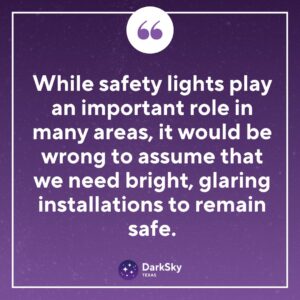One of the most important pillars in our battle against light pollution is to minimize or eliminate unnecessary outdoor lighting. However, when we travel across the state explaining the 5 Principles of Responsible Outdoor Lighting, the number one objection we hear is the concern that removing and changing outdoor lighting would make them feel less secure. Most people believe that outdoor lighting deters criminals and makes their property safer, but is that really the case?
The idea that we might be jeopardizing our families or properties in the name of “better lighting” is a hard sell. In this blog, we want to dig deeper into the question of whether security lights make us safer or is it an illusion. How can we be “night sky friendly” with our security lights and still deter criminals from our property? And perhaps more importantly, are security lights needed at all or do they just show criminals where there might be goods to steal?
What Makes a Security Light or Outdoor Night Light “Good”
Security lights are outdoor lights meant to keep us safe. The goal of the light is to improve visibility in an area, deter possible intruders, and make it easier to see at night to prevent accidents for welcomed visitors in areas such as a driveway, a busy street crossing, or a set of outdoor stairs.
However, some security lights actually make it more difficult to see welcomed visitors and make your home more susceptible to crime. For example, imagine pulling into a friend’s driveway at night. They have an outdoor light on their house that is supposed to help you see where to park and walk to the house, but the light is so bright that it makes it more difficult to see because the glare makes you shield your eyes. Does this light make you or the home safer? No, it doesn’t. Instead, it creates shadows and blind spots where your eyes cannot see because of the brightness and glare. These spots are perfect for criminals to hide in, making the home, driver, and anyone in the driveway, like a child or animal, less secure.
The 5 Principles of Responsible Outdoor Lighting
Finding “good” lights that don’t create light pollution, glare, and light trespass will always involve following the 5 Principles of Responsible Outdoor Lighting. These principles are just as applicable to security lights as to decorative installations.
Good security lights should be useful, targeted, no brighter than necessary, controlled, and warm-colored. And so, it doesn’t take us long to imagine security lights that:
- Are directed only toward the paths where we need them
- Use shields to remove glare and decrease “light spills” outside the targeted area
- Keep their intensity low enough to let us see in the illuminated area and beyond rather than have our eyes adjusted to a very bright area with dark shadows beyond it
- Use motion sensors to activate only when people or cars are around
- Employ warmer lighting colors, yellow or orange hues rather than blue-violet (white) ones.
Some of these features, such as shields, may require property owners to adjust their existing systems slightly. Others, like motion sensors, are already expected features of most modern security systems.
Can “Good” Lights Help Us Remain Safe?

Whenever our team advises Texas landowners on security light solutions, one question inevitably arises: Will these changes keep me equally safe? In 2014, a large study conducted across England and Wales tested the effectiveness of different types of security lighting on road safety. The researchers observed strategic crossroads across 62 jurisdictions for over three years.
They found that warm colors and shields did not decrease the effectiveness of any security lights. The spots that switched to “night sky friendly” systems did not suffer from any extra accidents or break-ins when compared to those that kept their old systems. In addition, the use of timers and motion sensors as opposed to permanent lights didn’t make any property more likely to be a victim of crime.
Do We Need Bright Lights at Night to Keep Us Safe?
As more researchers explore solutions to light pollution, we are driven to challenge another fundamental assumption: Are security lights necessary to keep us safe?
Here, the answer becomes more complicated.
Regarding car accidents, we undoubtedly need lighting to navigate a driveway or a treacherous street crossing. However, this doesn’t mean that more lights are better. On the contrary, unshielded lights and overly bright LED bulbs can create dangerous levels of glare, temporarily blinding drivers to an upcoming hazard. In this sense, the 5 Principles mentioned earlier increase everyone’s safety and protect the environment.
When it comes to crime, we have more factors to consider. Policing and crime stats are complex and subject to physical and socio-economic factors. But when we look at the big numbers—such as a 1997 report by the National Institute of Justice—we find that security lights make very little difference when protecting a property against vandalism or burglars.
This may feel paradoxical, as we are used to thinking of darkness as inherently dangerous. But let’s keep a very simple fact in mind: criminals need lights too. Brightly-lit alleys are more likely to be targeted by vandals and burglars, who can now see which window they’re aiming for – and are led to believe that a well-lit area hides a more valuable prize.
Final Thoughts: It’s All in the Design
Our brains are wired to associate light with clarity, safety, and transparency – even if reality sometimes betrays this link. While safety and security lights play an important role in many areas, it would be wrong to assume that we need bright, glaring installations to remain safe. We can create cost-effective installations that will keep us safer while minimizing light pollution, lowering our electricity bills, and making our neighbors (humans and animals) much happier.
Following the 5 Principles of Responsible Outdoor Lighting lets you see better and is a win-win for everyone (except the criminal)!

